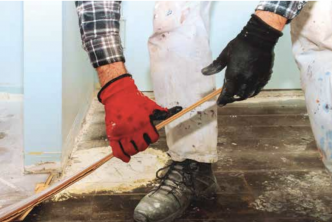by Timothy E. Hull, CR
Making sure the customer service failure does not happen again is the hardest part of the process, because it requires the business to make and keep a commitment to the customer.
This past year my wife and I finally got around to having the glass shower doors installed in our master bathroom. The contractor we hired was working on the project when I eagerly walked into the room to check on his progress. He glanced at me with a frustrated look on his face. When I apprehensively asked what was wrong, he pointed to a 1/8”-long scratch that was directly at eye-level on the clear glass door. Before I could say anything, he immediately told me what he was going to do to correct the situation.
We’ve all heard the cliché, “It is not the problem, but the solution that matters.” If this is true, the restoration business should be called the Solution Industry. Whether it’s personality conflicts, unrealistic expectations, poor communication, or lackluster execution, customer service failures are an everyday p art of this business. Most business owners and managers would like to think their company delivers flawless service—and some take admirable steps to get close— but in reality, even the best companies screw up at least once in a while.
For those companies whose reality is like most, there is good news. You can recover. And, if you recover properly, there is a high probability of creating customer loyalty greater than before the customer service failure occurred. This situation is often referred to as The Service Recovery Paradox. The theory almost seems ludicrous in some respects. To think that a customer would be more loyal after having a b ad experience, even with an appropriate recovery, doesn’t sound logical.
Picture yourself waiting to check out at your favorite supply s tore. The person working the sales counter is obviously not aware of your preferred customer status. They are trying to complete a transaction for the customer in front of you when there is an issue with the bar code scanner. The sales associate calls for help and you both wait… and wait and wait. Ten minutes later, without even acknowledging the situation, the associate offers a half-hearted apology and you are on your way―now late for a meeting with your customer and irritated enough to take your business elsewhere.
In similar situations, some would choose to call the store manager and complain. The store manager would apologize and maybe even offer modest compensation, such as a discount on your next purchase. To me that reduces loyalty, not increases it. However, if the store manager were to offer you a dedicated “preferred contractor” sales desk and assign a sales associate to your account in an effort to ensure the situation doesn’t happen again, then we might be getting somewhere.
The reason the second recovery scenario works is because an unhappy customer’s loyalty is not based on the past experience, but rather on their fear of future failures. Consequently, unless the contractor provides a way to minimize or eliminate the risk of future failures, loyalty is impossible to achieve, as they may never get the second chance.
So, what does a good customer service recovery process look like? For me it is simple: own the problem; fix the problem; make sure the problem doesn’t happen again.
Owning the problem generally means accepting responsibility for the consequences of the service failure. This starts with a sincere apology for any inconvenience it may have caused the customer. It is recommended to do more listening than talking at this stage. Even if you don’t agree with the customer (who IS always right, by the way) the problem still needs to be acknowledged and accepted. Being “present” with the customer and having empathy for their situation is often as powerful as any compensation that may follow.
Fixing the problem is the easiest part of the process and usually that at which restoration contractors are best. As long as the action is in alignment with what the customer perceives will rectify the situation, then the resolution is sound. With this in mind, I would offer two pieces of advice. First, act swiftly. This conveys to the customer that you are acting with the same sense of urgency as they view the situation. Second, do not offer meaningless compensation. An attempt to “buy-off” a problem rarely ends well for either party. This sends the message that the relationship with the customer is merely transactional and you have no interest in future business.
Making sure the customer service failure does not happen again is the hardest part of the process, because it requires the business to make and keep a commitment to the customer. It also requires involvement from multiple levels of the organization to formulate implementable plans of action to prevent similar situations from occurring in the future. However, these plans cannot be developed in haste or operational procedures become a patchwork of bandages that address only symptoms and not root causes.
Truly addressing service delivery failures should involve an analysis of categorical trends over a period of time. These failures will generally fall into a few categories such as scheduling, communication, or planning that can be dealt with more strategically than tactically. This is known as a procedural approach to problem solving. Other issues related more to personnel can also be present and should be dealt with swiftly on an individual basis.
As for my glass installer, he executed his customer service recovery perfectly. He immediately apologized for the situation, even going so far as to acknowledge the inconvenience it might cause us by not having use of the shower. He let us know that he really should have inspected the glass before he left the shop and definitely before he started mounting the hinges and bottom frame. He had already ordered new glass even before making me aware of the issue, and said he would schedule the replacement installation as soon as it came in. His finishing touch for the recovery was when he proceeded to install the defective door anyway, because he didn’t want us to be without use of the shower while we waited for the replacement. He did this, even knowing that he was not going to be paid for the additional time.
Regardless of the situation, customer service issues are a part of every service business. Resolving the issue and implementing a successful customer recovery in a timely manner should be an integral part of every restorer’s operating procedures. Getting it right is critical to customer loyalty and future referrals. Don’t hide from your company’s service failures. Own them; fix them; make sure they don’t happen again, and you might just create one of the most powerful sources for repeat business―loyal customers.
Just four months after our shower door project was finished, my 9-year son and his buddy broke a 40-square–foot picture window in our sunroom while playing baseball in the back yard. Guess who I called?





